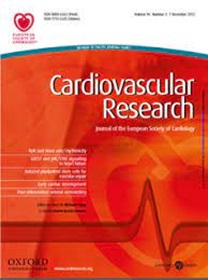In PLN-R14del mice, SR structure restoration, rather than calcium cycling, is the dominant effector of PLN-ASO treatment.
IF 13.3
1区 医学
Q1 CARDIAC & CARDIOVASCULAR SYSTEMS
引用次数: 0
Abstract
AIMS Phospholamban (PLN) acts as an inhibitory regulator of calcium uptake in the sarco-/endoplasmic reticulum (SR) of cardiomyocytes. The pathogenic variant, PLN-R14del, leads to dilated and/or arrhythmogenic cardiomyopathy. Previous studies demonstrated that PLN-targeting antisense oligonucleotides (ASOs) can mitigate disease progression in mice. However, it remains unclear whether the protective effects of PLN-ASO therapy are due to improved calcium homeostasis or via reduction of abnormal PLN-SR clusters, a hallmark of this disease. METHODS AND RESULTS : Homozygous PLN-R14del (R14Δ/Δ) mice were randomized to injections with various doses of PLN-ASO (3, 7, 15 or 25 mg/kg) or a scrambled control. Consistent with previous findings, R14Δ/Δ mice exhibited severe cardiac dysfunction, myocardial fibrosis, and aberrant SR clusters by 7 weeks of age. ASO-treated R14Δ/Δ mice displayed a dose-dependent preservation of cardiac function with diminished remodeling and extended lifespan. Correspondingly, abnormal PLN-SR clustering was diminished by ASO therapy in a dose-dependent manner, and SR structure returned to a normal state. Calcium dynamics were investigated separately on isolated cardiomyocytes from treated mice. In wild-type (WT) mice, ASO (25 mg/kg) mediated PLN depletion significantly enhanced calcium and contractile dynamics, confirming effective target engagement. In R14Δ/Δ cardiomyocytes, however, ASO treatment showed limited effects on calcium dynamics. Calcium transient decay and sarcomeric shortening were already enhanced in R14Δ/Δ cardiomyocytes compared to WT, suggesting a partial loss of the PLN-R14del calcium inhibitory function. This preexisting acceleration of calcium dynamics likely accounts for the limited impact of ASO therapy on calcium regulation in R14Δ/Δ mice. CONCLUSIONS PLN-ASO treatment demonstrated a dose-dependent restoration of SR organization and a concomitant increase in lifespan in PLN-R14del mice. The enhanced SR calcium uptake in PLN-R14del mice suggests a partial loss of inhibitory function, limiting ASO therapy's effects on calcium dynamics. This implies that PLN-ASO therapy acts predominantly via restoration of SR structure in PLN-R14del cardiomyopathy.在PLN-R14del小鼠中,SR结构恢复,而不是钙循环,是PLN-ASO处理的主要效应。
AIMSPhospholamban (PLN)是一种抑制心肌细胞肌/内质网(SR)钙摄取的调节剂。致病变异PLN-R14del可导致扩张性和/或心律失常性心肌病。先前的研究表明,靶向pln的反义寡核苷酸(ASOs)可以减缓小鼠的疾病进展。然而,目前尚不清楚PLN-ASO治疗的保护作用是由于改善钙稳态还是通过减少异常PLN-SR簇,这是该疾病的标志。方法与结果:将纯合子PLN-R14del (R14Δ/Δ)小鼠随机分为注射不同剂量的PLN-ASO(3、7、15或25 mg/kg)或胡乱对照。与先前的研究结果一致,R14Δ/Δ小鼠在7周龄时表现出严重的心功能障碍、心肌纤维化和异常的SR簇。aso处理R14Δ/Δ小鼠显示出剂量依赖性的心脏功能保存,重塑减少,寿命延长。相应的,ASO治疗以剂量依赖的方式减少了异常的PLN-SR聚集,SR结构恢复到正常状态。分别对小鼠心肌细胞钙动力学进行了研究。在野生型(WT)小鼠中,ASO (25 mg/kg)介导的PLN耗损显著增强了钙和收缩动力学,证实了有效的靶作用。然而,在R14Δ/Δ心肌细胞中,ASO治疗对钙动力学的影响有限。与WT相比,R14Δ/Δ心肌细胞中的钙瞬态衰变和肌体缩短已经增强,这表明PLN-R14del钙抑制功能部分丧失。这种预先存在的钙动力学加速可能解释了ASO治疗对R14Δ/Δ小鼠钙调节的有限影响。结论spln - aso治疗显示出PLN-R14del小鼠SR组织的剂量依赖性恢复和伴随的寿命延长。PLN-R14del小鼠SR钙摄取增强表明部分抑制功能丧失,限制了ASO治疗对钙动力学的影响。这表明PLN-ASO治疗主要通过恢复PLN-R14del心肌病的SR结构起作用。
本文章由计算机程序翻译,如有差异,请以英文原文为准。
求助全文
约1分钟内获得全文
求助全文
来源期刊

Cardiovascular Research
医学-心血管系统
CiteScore
21.50
自引率
3.70%
发文量
547
审稿时长
1 months
期刊介绍:
Cardiovascular Research
Journal Overview:
International journal of the European Society of Cardiology
Focuses on basic and translational research in cardiology and cardiovascular biology
Aims to enhance insight into cardiovascular disease mechanisms and innovation prospects
Submission Criteria:
Welcomes papers covering molecular, sub-cellular, cellular, organ, and organism levels
Accepts clinical proof-of-concept and translational studies
Manuscripts expected to provide significant contribution to cardiovascular biology and diseases
 求助内容:
求助内容: 应助结果提醒方式:
应助结果提醒方式:


